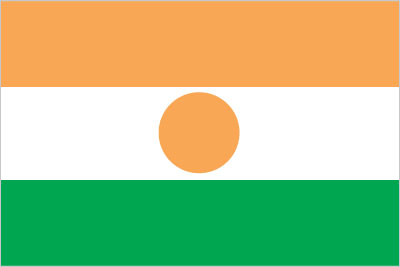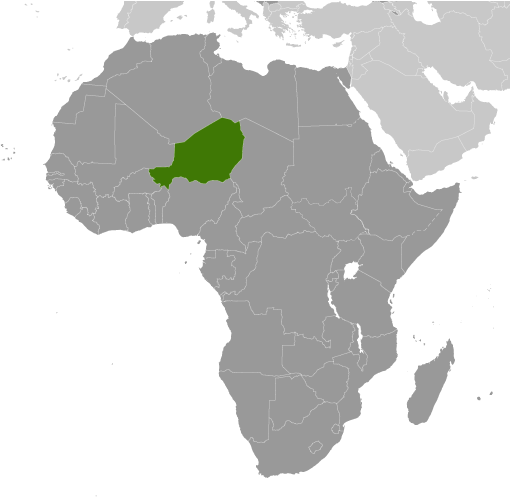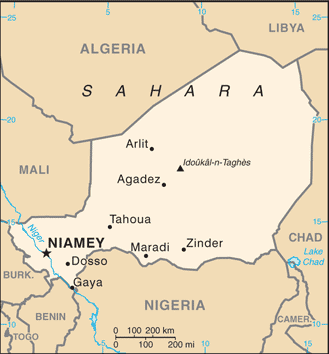|
Economy - overview:
|

|
|
Niger is a landlocked, Sub-Saharan nation, whose economy centers on subsistence crops, livestock, and some of the world's largest uranium deposits. Agriculture contributes about 40% of GDP and provides livelihood for about 90% of the population. Niger also has sizable reserves of oil, and oil production, refining, and exports are expected to grow significantly between 2011 and 2016. Drought, desertification, and strong population growth have undercut the economy. Niger shares a common currency, the CFA franc, and a common central bank, the Central Bank of West African States (BCEAO), with seven other members of the West African Monetary Union. In December 2000, Niger qualified for enhanced debt relief under the International Monetary Fund program for Highly Indebted Poor Countries (HIPC) and concluded an agreement with the Fund on a Poverty Reduction and Growth Facility (PRGF). Debt relief provided under the enhanced HIPC initiative significantly reduced Niger's annual debt service obligations, freeing funds for expenditures on basic health care, primary education, HIV/AIDS prevention, rural infrastructure, and other programs geared at poverty reduction. In December 2005, Niger received 100% multilateral debt relief from the IMF, which translated into the forgiveness of approximately US$86 million in debts to the IMF, excluding the remaining assistance under HIPC. The economy was hurt when the international community cut off non-humanitarian aid in response to TANDJA's moves to extend his term as president. Nearly half of the government's budget is derived from foreign donor resources. Future growth may be sustained by exploitation of oil, gold, coal, and other mineral resources. The government, however, has made efforts to secure a new three-year extended credit facility with the IMF following the one that completed in 2011. Oil revenue to the government has fallen well short of its budgeted level. Strikes risk undermining political stability. Food security remains a problem in Niger and is exacerbated by refugees from Mali.
|
|
|
GDP (purchasing power parity):
|

|
|
$13.53 billion (2012 est.)
country comparison to the world: 144
$11.82 billion (2011 est.)
$11.56 billion (2010 est.)
note:
data are in 2012 US dollars
|
|
|
GDP (official exchange rate):
|

|
|
$6.556 billion (2012 est.)
|
|
|
GDP - real growth rate:
|

|
|
14.5% (2012 est.)
country comparison to the world: 3
2.3% (2011 est.)
8% (2010 est.)
|
|
|
GDP - per capita (PPP):
|

|
|
$900 (2012 est.)
country comparison to the world: 220
$800 (2011 est.)
$800 (2010 est.)
note:
data are in 2012 US dollars
|
|
|
GDP - composition by sector:
|

|
|
agriculture: 39.6%
industry:
17.1%
services:
43.2% (2012 est.)
|
|
|
Labor force:
|

|
|
4.688 million (2007)
country comparison to the world: 84
|
|
|
Labor force - by occupation:
|

|
|
agriculture: 90%
industry:
6%
services:
4% (1995)
|
|
|
Unemployment rate:
|

|
|
NA%
|
|
|
Population below poverty line:
|

|
|
63% (1993 est.)
|
|
|
Household income or consumption by percentage share:
|

|
|
lowest 10%: 3.7%
highest 10%:
28.5% (2007)
|
|
|
Distribution of family income - Gini index:
|

|
|
34 (2007)
country comparison to the world: 93
50.5 (1995)
|
|
|
Budget:
|

|
|
revenues: $1.655 billion (2012 est.)
expenditures:
$1.927 billion (2012 est.)
|
|
|
Taxes and other revenues:
|

|
|
25.3% of GDP (2012 est.)
country comparison to the world: 122
|
|
|
Budget surplus (+) or deficit (-):
|

|
|
-4.1% of GDP (2012 est.)
country comparison to the world: 139
|
|
|
Inflation rate (consumer prices):
|

|
|
3.9% (2012 est.)
country comparison to the world: 107
2.9% (2011 est.)
|
|
|
Central bank discount rate:
|

|
|
4.25% (31 December 2009)
country comparison to the world: 73
4.75% (31 December 2008)
|
|
|
Commercial bank prime lending rate:
|

|
|
4% (31 December 2012 est.)
country comparison to the world: 166
4.3% (31 December 2011 est.)
|
|
|
Stock of narrow money:
|

|
|
$1.064 billion (31 December 2012 est.)
country comparison to the world: 148
$939.7 million (31 December 2011 est.)
|
|
|
Stock of broad money:
|

|
|
$1.201 billion (31 December 2011 est.)
country comparison to the world: 163
$1.171 billion (31 December 2010 est.)
|
|
|
Stock of domestic credit:
|

|
|
$1.04 billion (31 December 2012 est.)
country comparison to the world: 157
$825.3 million (31 December 2011 est.)
|
|
|
Market value of publicly traded shares:
|

|
|
$NA
|
|
|
Agriculture - products:
|

|
|
cowpeas, cotton, peanuts, millet, sorghum, cassava (manioc), rice; cattle, sheep, goats, camels, donkeys, horses, poultry
|
|
|
Industries:
|

|
|
uranium mining, cement, brick, soap, textiles, food processing, chemicals, slaughterhouses
|
|
|
Industrial production growth rate:
|

|
|
5.1% (2003 est.)
country comparison to the world: 57
|
|
|
Current account balance:
|

|
|
-$1.628 billion (2012 est.)
country comparison to the world: 130
-$1.697 billion (2011 est.)
|
|
|
Exports:
|

|
|
$1.654 billion (2012 est.)
country comparison to the world: 147
$1.249 billion (2011 est.)
|
|
|
Exports - commodities:
|

|
|
uranium ore, livestock, cowpeas, onions
|
|
|
Exports - partners:
|

|
|
US 49.2%, Nigeria 29.4%, Russia 10.3%, Ghana 4.1% (2011)
|
|
|
Imports:
|

|
|
$2.491 billion (2012 est.)
country comparison to the world: 157
$2.217 billion (2011 est.)
|
|
|
Imports - commodities:
|

|
|
foodstuffs, machinery, vehicles and parts, petroleum, cereals
|
|
|
Imports - partners:
|

|
|
France 15.6%, China 9.7%, Nigeria 8.9%, French Polynesia 8.5%, Belgium 6.9%, India 6.1%, Togo 4.7% (2011)
|
|
|
Debt - external:
|

|
|
$1.451 billion (31 December 2012 est.)
country comparison to the world: 146
$1.342 billion (31 December 2011 est.)
|
|
|
Exchange rates:
|

|
|
Communaute Financiere Africaine francs (XOF) per US dollar -
514.1 (2012 est.)
471.87 (2011 est.)
495.28 (2010)
472.19 (2009)
447.81 (2008)
|
|
|
Fiscal year:
|

|
|
calendar year
|
|
|
|





 )
)



